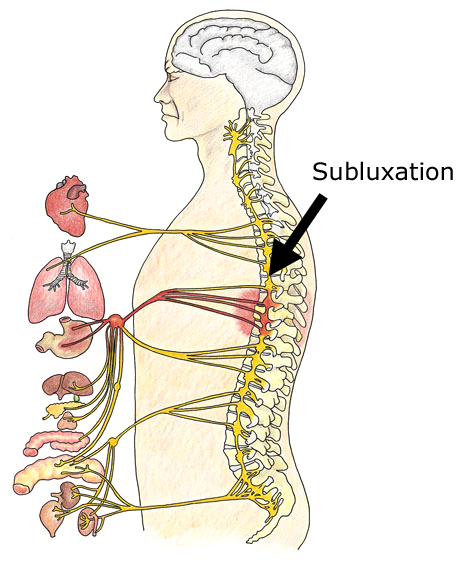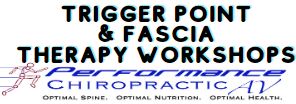WHY HAS CHIROPRACTIC BECOME SO POPULAR? 
Why has chiropractic become so popular? It is because doctors of chiropractic are the only professionals trained to locate and correct subluxations. If subluxations are in your body, you cannot be truly healthy. What are these subluxations? How were they discovered?
HOW WERE SUBLUXATIONS DISCOVERED?
Dr. Daniel David Palmer was a successful natural healer in Davenport, Iowa at the turn of the twentieth century. He examined a deaf man and found a spinal bone (vertebra) slightly out of its normal position. Palmer adjusted the vertebra back into place and the man’s hearing returned! Dr. Palmer examined other patients’ spines and found more of these abnormally positioned vertebrae. He wrote: Shortly after this relief from deafness, I had a case of heart trouble which was not improving. I examined the spine and found a displaced vertebra pressing against the nerves which innervate the heart. I adjusted the vertebra and gave immediate relief. Then I began to reason if two diseases so dissimiliar as deafness and heart trouble, came from impingement, a pressure on nerves, were not other diseases due to a similar cause?1
Such was the discovery of chiropractic and the subluxation. In many ways it was a re-discovery of the ancient art of structural system alignment found in nearly every culture throughout history.
Palmer’s “displaced vertebrae … [causing] a pressure on nerves” is now commonly referred to as a subluxation.2 Subluxation is a term used to describe the phenomenon by which chiropractors get such good results. Research reveals the subluxation involves structural distortions that affect brain and nerve function.3
WHAT DOES THE SUBLUXATION DO?
Subluxations cause body malfunction (dis-ease) which results in lowered resistance to disease, pain, imbalance and fatigue and can pave the way for ill health in almost any part of the body. Subluxations are sometimes referred to as “silent killers” because they can slowly eat away at your health and vitality for years without your knowing it.
Subluxation damage includes the following components:4
- Joint damage (kinesiopathology)
Your structure is misaligned. You may not be able to turn your head, hips or other body parts around equally well or as far as possible (reduced range of motion). You may have “noisy joints.”5
- Nerve damage (neuropathology)
There is stress on your nerves. Chemicals and messages that flow over the nerves may be blocked. You may feel nothing or there may be pain and other symptoms.6
- Muscle damage (myopathology)
Your muscles are tight, in spasm, weak, overly sensitive and/or sore. Your posture is unbalanced, resulting in fatigue and increased joint wear and tear.7
- Tissue damage (histopathology)
You have tender “trigger points” or painful spots. Ligaments, cartilage, discs, tendons and internal organs may be affected resulting in osteoarthritis or spinal degeneration.8
- Overall body malfunction (pathophysiology)
Eventually long-standing subluxations cause your muscles, joints, ligaments and organs to show signs of wear and tear, premature aging, fatigue, less resistance to disease and lack of physical and mental vitality. Internal organ disease, spinal degeneration and disc herniation may occur after years of subluxation damage.9-11
Subluxations are caused by accidents, falls, sports injuries, birth stress and other trauma or by bad posture or even by emotional stress. Infants and children need to have their structural systems checked by a doctor of chiropractic as neurological and other health problems have been traced to structural damage at birth or in infancy.
CORRECTING SUBLUXATIONS
Nearly everyone has subluxations at one time or another. It is sometimes said that if you suffer from neck and back pain you’re lucky—you are aware of a problem and will (hopefully) go to a doctor of chiropractic for a checkup. The chiropractor will not only check the areas in pain, but will throw in a “bonus” and check your entire body for subluxations, even the areas that don’t hurt.
BENEFITS OF CHIROPRACTIC
Various studies have revealed the effects and benefits of subluxation correction. In addition to pain reduction, chiropractic patients also experience significant improvements in overall physical health and mental/emotional health. They report sleeping better and improvements in lifting, walking, standing, sex life, social life and ability to travel. These benefits of chiropractic care were found in all age groups.12-17
 GET A CHIROPRACTIC CHECKUP NOW
GET A CHIROPRACTIC CHECKUP NOW
Because subluxations are often painless, periodic chiropractic checkups should be a part of every family’s healthcare routine. Correcting silent subluxations today will help ensure greater physical and emotional health now and may well save you and your family from serious health problems that, later in life, could not possibly be ignored.
Call us at Performance Chiropractic and schedule your check up! (661) 942-5000.
References
- Palmer DD. The Science, Art and Philosophy of Chiropractic (The Chiropractor’s Adjuster). Portland, OR: Portland Printing House Company. 1910.
2. Cooperstein R, Gleberzon BJ. Technique Systems In Chiropractic. London: Churchill Livingstone/Elsevier Health Sciences. 2004. - Lantz CA. The vertebral subluxation complex. International Review of Chiropractic. September/October 1989;45(5):37-58.
- Keating J. Evaluating the quality of clinical practice guidelines. JMPT. 2003;26(3):209-211.
- Cramer G, Fournier J, Henderson C, Wolcott C. Degenerative changes following spinal fixation in a small animal model. JMPT. 2004;27(3):141-154.
- Henderson CNR. Three neurophysiologic theories on the chiropractic subluxation. In MI Gatterman (Ed.), Foundations of Chiropractic: Subluxation. St. Louis, MO: Mosby. 1995.
- Lantz CA. The vertebral subluxation complex part 2: the neuropathological and myopathological components. CRJ. 1990;1(4):19.
- Salter RB. Textbook of Disorders and Injuries of the Musculoskeletal System. Baltimore, MD: Williams and Wilkins. 1970.
- Akeson W et al. Collagen crosslinking alterations in joint contractures: changes in reducible cross-links in periarticular connective tissue: collagen after nine weeks of immobilization. Connect Tissue Res. 1977;5(1):15-19.
- Dishman RW. Static and dynamic components of the chiropractic subluxation complex: a literature review. JMPT. 1988;11(2):98-107.
- Leach RA. Chapter 12: Neurodystrophic hypothesis. In The Chiropractic Theories: A Synopsis of Scientific Research (2nd ed.). Baltimore, MD: Williams and Wilkins. 1986.
- Blanks RHI et al. A retrospective assessment of network care using a survey of self-rated health, wellness and quality of life. JVSR. 1997;1(4):41-48.
13. Welch A, Boone R. Sympathetic and parasympathetic responses to specific diversified adjustments to chiropractic vertebral subluxations of the cervical and thoracic spine. J of Chiropractic Medicine. 2008;7(3):86-93.
14. Senzon SA et al. The Network Spinal Wave as a central pattern generator. Vertebral Subluxation Res. April 24, 2015. IRAPS 2014 symposium.
15. Hoiriis KT, Owens EF. Changes in general health status during upper cervical chiropractic care: a practice-based research project update. CRJ. 1999;6(2):65-70.
16. Roy RA, Boucher JP, Comtois AS. Autonomic tone affected by vertebral subluxations and its adjustment. Heart rate variability modulation after manip-ulation in pain-free patients vs. patients in pain. JMPT. 2009;32(4):277-286.
17. Study associates chiropractic with better health in the elderly. Today’s Chiropractic. November/December 1996.






FOLLOW US!